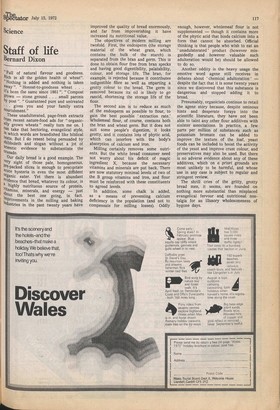Science
Staff of life
Bernard Dixon
"Pull of natural flavour and goodness. Rich in all the golden health of wheat". "Nothing is added and nothing is taken tt,Way ". "Honest-to-goodness wheat . . . It's been die same since 1861 ". "Compost P•own — stone ground . . . small parcels by post ". "Guaranteed pure and untreated • . gives you and your family extra nourishment."
These unadulterated, page-fresh extracts from recent nature-food ads for "organically grown wheats" really turn me on. I Fan take that hectoring, evangelical style, In which words are brandished like biblical texts. But I do resent being persuaded by Shibboleth and slogan without a jot of soientic evidence to substantiate the etOsade.
Our daily bread is a good example. The verY sight of those pale, homogeneous, Pre-packed slices is enough to precipitate acute hysteria in even the most diffident Wganic eater. Yet there is abundant evidence that bread, whatever, its colour, is ahighly nutrituous source of protein, vitamins, minerals, and energy — just "bout the best one going, in fact.
provements in the milling and baking In4ustries in the past twenty years have
improved the quality of bread enormously, and far from impoverishing it have increased its nutritional value.
The objectives of modern milling are twofold. First, the endosperm (the storage material of the wheat grain, which contains the bulk of the starch) is separated from the bran and germ. This is done to obtain flour free from bran specks and having good digestibility, palatability, colour, and storage life. The bran, for example, is rejected because it contributes indigestible fibre as well as iniparting a grotty colour to the bread. The germ is removed because its oil is likely to go rancid, shortening the storage life of the flour.
The second aim is to reduce as much of the endosperm as possible to flour, to gain the best possible 'extraction rate.' Wholemeal flour, of course, contains both the bran and wheat germ. But it does not suit some people's digestion, it looks grotty, and it contains lots of phytic acid, which can interfere with the body's absorption of calcium and iron.
Milling certainly removes some nutrients. But the white bread consumer need not worry about his deficit of magic ingredient X, because the necessary vitamins and minerals are put back. There are now statutory minimal levels of two of the B group vitamins and iron, and flour must be reinforced with these constituents to agreed levels.
In addition, some chalk is added, as a means of preventing calcium deficiency in the population (and not to compensate for milling losses). Oddly enough, however, wholemeal flour is not supplemented — though it contains more of the phytic acid that binds calcium into a form that cannot be absorbed. Official thinking is that people who wish to eat an unadulaterated ' product (however misguidedly and however valuable such adulteration would be) should be allowed to do so.
Another oddity is the heavy usage the emotive word agene still receives in debates about 'chemical adulteration' — despite the fact that it is some twenty years since we discovered that this substance is dangerous and stopped adding it to bread.
Presumably, organicists continue to retail the agene story because, despite ominous hints and desperate forays into the scientific literature, they have not been able to taint any other flour additives with sinister associations. In practice, a few parts per million of substances such as potassium bromate can be added to improve the texture of the loaf, yeast foods can be included to boost the activity of the yeast and improve crust colour, and preservatives may also be used. But there is no adverse evidence about any of these additives, which on a priori grounds are most unlikely to be harmful, and whose use in any case is subject to regular and stringent review.
The shrill cries of the gritty, grotty bread men, it seems, are founded on nothing more substantial than misplaced evangelical fervour and nutritional nostalgia for an illusory wholesomeness of bygone days.










































 Previous page
Previous page